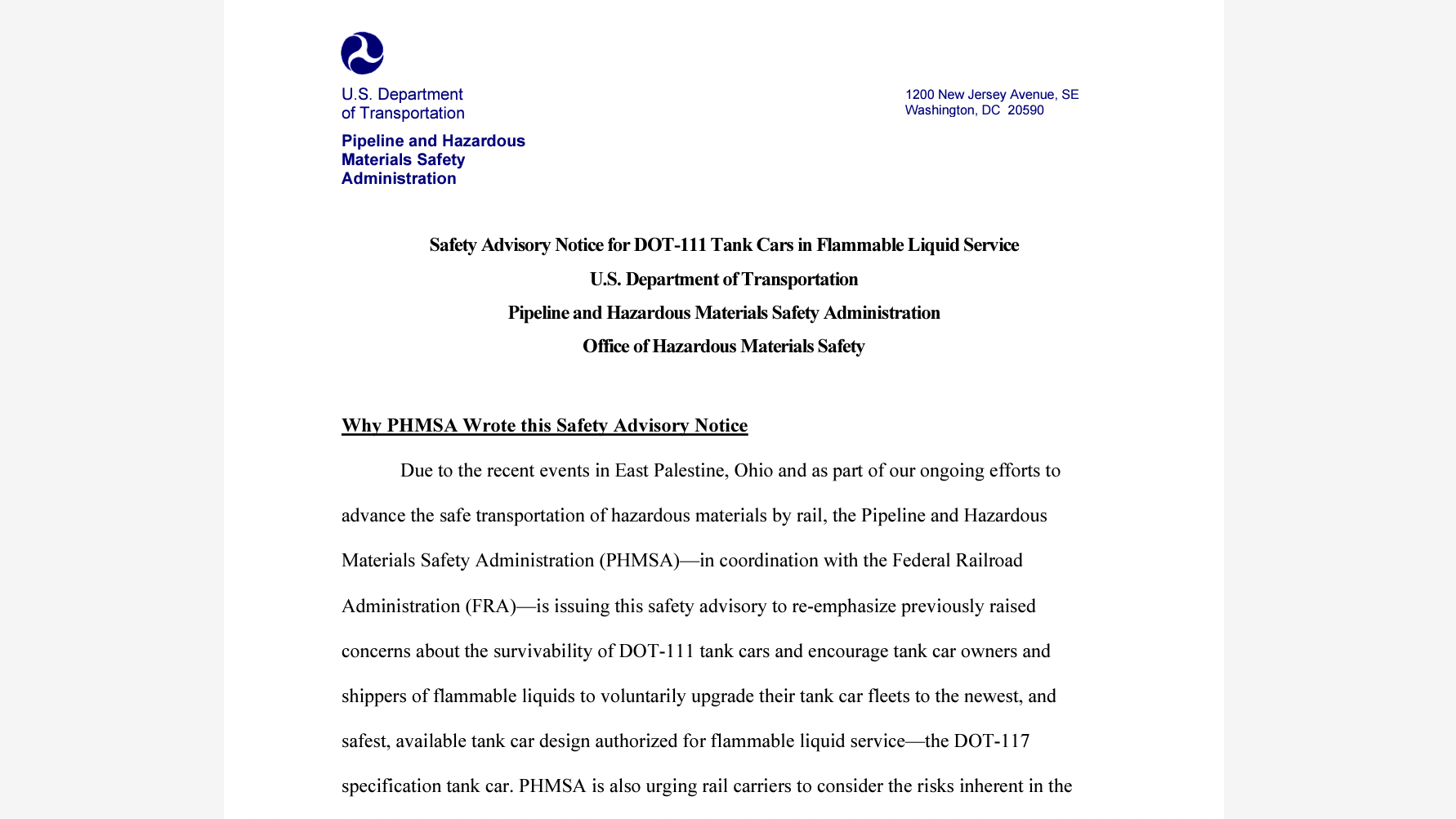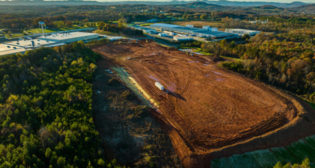
PHMSA Issues DOT-111 Tank Car Safety Advisory
Written by Marybeth Luczak, Executive Editor
The Pipeline and Hazardous Materials Safety Administration (PHMSA), in coordination with the Federal Railroad Administration (FRA), on March 22 released a safety advisory, which it said was to “re-emphasize previously raised concerns about the survivability of DOT-111 tank cars and encourage tank car owners and shippers of flammable liquids to voluntarily upgrade their tank car fleets to the newest, and safest, available tank car design authorized for flammable liquid service—the DOT-117 specification tank car.”
PHMSA reported that the move follows the Feb. 3 Norfolk Southern (NS) derailment in East Palestine, Ohio, and is part of its “ongoing efforts to advance the safe transportation of hazardous materials by rail.”
Additionally, PHMSA said it “urging rail carriers to consider the risks inherent in the continued use of DOT-111 tank cars in flammable liquid service, and to consider applying the requirements applicable to high-hazard flammable trains (HHFT) to trains with fewer tank cars carrying flammable liquids in DOT-111 tank cars. These concrete steps would reduce the risks of hazardous material transportation by rail. It is in the interest of safety and protection of human lives and the environment to use the best available tank car, as well as to voluntarily adopt operational controls applicable to HHFT trains to trains containing fewer tank cars carrying flammable liquids.”
In the safety advisory (download below), PHMSA reported that preliminary incident data released by the Environmental Protection Agency (EPA) on the East Palestine derailment “highlights that the performance of the DOT-111 specification tank cars involved in the derailment continues to be a significant concern. Publicly available data showing the train consist and positioning of the railcars involved in the derailment indicates that 16 DOT-111 specification tank cars were involved in the East Palestine derailment and fire. Seven of these DOT-111 tank cars experienced head and/or shell breaches—three of them contained hazmat that was released. Additionally, three DOT-111 specification tank cars containing nonhazardous material released product through other areas—two through their bottom outlet valves and one through a leak in the top fittings. Overall, of the 16 DOT-111 tank cars involved, over half of the tank cars released material as a direct result of the derailment.”
PHMSA noted that “[a]necdotally, of the three DOT-117 tank cars and six DOT-105 tank cars involved, only one of them released any product as a direct result of the derailment—a small leak in a DOT-117 tank car transporting petroleum lube oil which is a non-hazardous material. Three days after the derailment, on February 6, emergency responders conducted a controlled release of the contents of five DOT-105 tank cars containing vinyl chloride to vent pressure to prevent an explosion.”
PHMSA provided the disclaimer that its safety advisory “is considered guidance pursuant to DOT Order 2100.6A (June 7, 2021). Except when referencing laws, regulations, policies, or orders, the information in this safety advisory does not have the force and effect of law and is not meant to bind the public in any way. This document does not revise or replace any previously issued guidance. PHMSA and FRA may take additional regulatory actions in the future if the National Transportation Safety Board (NTSB) investigation of the East Palestine, Ohio derailment reveals the need for more concrete advisories or requirements.”
DOT-111s
On May 8, 2015, PHMSA, in coordination with FRA, published a final rule creating a new tank car specification, which it said addresses “the deficiencies in the DOT-111’s safety systems. Commonly known as the DOT-117J, this new tank car specification features a metal jacket, thermal protection system, top-fitting protection, disengaging bottom outlet handles, normalized steel and a minimum thickness of 9/16th inches—a 12.5% improvement in thickness as compared to the DOT-111 tank car design minimum.”
The final rule also created a pathway to retrofit existing DOT-111 tank cars (including DOT-111 tank cars built to the CPC-1232 specifications) to the DOT-117 standard, in a tank car specification known as the DOT-117R, according to PHMSA. “The May 2015 final rule, commonly known as the HHFT rule, created a phaseout schedule for DOT-111 tank cars in flammable liquid service based on the relative hazards of the flammable liquid materials transported,” the agency reported in its safety advisory. “These phaseout requirements were originally limited to HHFTs, mainly petroleum crude oil and ethanol, due to the increased risks presented by the transportation of large blocks of tank cars.” PHMSA defined HHFT as “a train that is transporting 20 or more loaded tank cars of a Class 3 flammable liquid in a continuous block or a single train carrying 35 or more loaded tank cars of a Class 3 flammable liquid throughout the train consist.” It noted that the HHFT rule phaseout schedule would have prohibited the carriage of flammable liquids in DOT-111 tank cars in a HHFT by May 1, 2025.
The Fixing America’s Surface Transportation (FAST) Act in December 2015 changed the phaseout schedule for flammable liquid tank cars, according to PHMSA, which in August 2016, published a final rule to align the requirements of its regulations with the FAST Act. “The new phaseout applied to flammable liquids transported in all types of train arrangements—not just an HHFT,” PHMSA reported. “The FAST Act also set separate dates for crude oil and ethanol phaseouts, and allowed use of DOT-111 tank cars for other flammable liquids in Packing Group (PG) II and III (i.e., materials of medium and low hazard, respectively) until May 1, 2029.”
PHMSA pointed out in its safety advisory that the “FAST Act mandates authorized DOT-111 tank cars to remain in flammable liquid service until May 1, 2029, and does not provide the [U.S.] Secretary of Transportation with discretion to change this date. The NTSB [National Transportation Safety Board]—which advocated for a more aggressive phaseout schedule in Safety Recommendation R-15-16—recognized that PHMSA and the DOT as a whole had no further discretion to address this issue, noting, ‘[b]ecause the congressional mandates and industry actions have overtaken PHMSA’s ability to implement the recommended action, Safety Recommendation R-15-16 is classified ‘Closed—No Longer Applicable.’”
The bipartisan Railway Safety Act of 2023—introduced March 1 by Sens. J. D. Vance (R-Ohio), Marco Rubio (R-Fla.), Josh Hawley (R-Mo.), Sherrod Brown (D-Ohio), and Bob Casey and John Fetterman (D-Pa.)—proposes pushing up the phaseout schedule: “Beginning on May 1, 2025, a rail carrier may not use DOT–111 specification railroad tank cars that do not comply with DOT–117, DOT–117P, or DOT–117R specification requirements, as in effect on the date of enactment of this Act, to transport Class 3 flammable liquids regardless of the composition of the train consist.”
That legislation as well as the Feb. 3 derailment was addressed at a March 22 Senate Commerce Committee hearing. NS President and CEO Alan H. Shaw, one of many hearing witnesses, reported in his testimony that the railroad supports “accelerating the phaseout of older tank car models.”
Also a hearing witness, NTSB Chair Jennifer Homendy reported in testimony that NTSB “supports a shorter timeline to transition away from DOT-111s than what is currently in statute and regulation.” She added that “Congress should consider transitioning all other DOT-111s out of hazmat service.”
PHMSA: ‘Proactive Action Needed by Industry to Upgrade Their Flammable Liquid Tank Car Fleet Now!’
In the safety advisory, PHMSA reported that it “believes that it is possible, and in the clear safety interest of the public, for tank car owners and shippers using DOT-111 tank cars to acquire the DOT-117J, or even DOT-117R, specification tank cars they need to continue operating well before the May 1, 2029, phaseout.” According to the agency, there “is sufficient shop capacity to retrofit existing tank cars to the DOT-117R standard and to build new DOT-117J tank cars to replace the existing DOT-111 tank car and CPC-1232 tank car fleet.” It cited the Association of American Railroads [AAR], which “estimates that there is a need for approximately 27,000 DOT-117 tank cars to meet the current May 1, 2025 (PG I flammable liquids other than crude oil and ethanol) and May 1, 2029 (PG II and III flammable liquids other than crude oil and ethanol) phaseouts, compared to approximately 86,000 DOT-117 tank cars produced through new construction and retrofitting.”
AAR data “shows that DOT-117J production peaked at over 1,900 tank cars per month, and DOT-117R retrofit conversion peaked at approximately 750 tank cars per month,” PHMSA reported. “However, current production of new DOT-117J and DOT-117R retrofits has fallen precipitously from these peaks, to approximately 275 DOT-117Js produced and 90 DOT-117R retrofits per month. Based on the results highlighted in the Bureau of Transportation Statistics (BTS) and AAR reports, PHMSA is confident that with a strong commitment from the tank car industry, steel and labor are available in sufficient quantities to substantially increase the current rate of production and adopt the DOT-117 tank cars well ahead of the mandated phaseout schedules.”
In respect to tank car availability, PHMSA reported “it is notable that the three DOT-117 tank cars involved in the East Palestine, Ohio derailment were not in hazardous materials service at the time of the derailment. Two were carrying petroleum lube oil, and the third was carrying propylene glycol, none of which are not subject to regulation under the HMR as hazmat. Clearly DOT-117 tank cars are available for lease, and PHMSA applauds the shipper(s) involved for their commitment to safety in using a DOT-117 tank car in a service that did not require it.”
In sum, PHMSA reported that the “social and environmental costs of delaying a shift to the DOT-117 specification tank car—a car which has clearly demonstrated its superior performance in accident scenarios—should be paramount. Equally, there are significant potential economic repercussions to delaying safety improvements in a bid to reduce near-term costs, as demonstrated by the tragic consequences of the recent East Palestine, Ohio derailment.”
In related developments, PHMSA announced March 20 more than $25 million available in grant funding through its pipeline and hazardous materials (hazmat) safety programs for projects that will “train first responders, strengthen safety programs, improve safety, reduce environmental impacts, and educate the public on local safety initiatives.” Additionally, the agency on March 3 published a Safety Advisory Notice for railroad emergency preparedness, in response to the Feb. 3 derailment.



